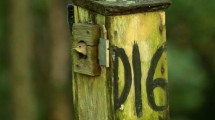Summary
We investigated whether nestling American robins (Turdus migratorius) were capable of influencing food distribution in their nests by perceiving that certain sectors of the nest received a relatively high proportion of feedings and positioning themselves accordingly. Feeding observations were obtained from videotape recordings taken at different stages of the nestling period. Parents generally arrived at a predictable location on the nest rim and allocated proportionally more food to nestlings in the central position. The degree of nestling movement was significantly positively correlated with variation in the predictability of parental arrival locations on the nest rim. Furthermore, nestlings moved more in broods suffering brood reduction. This suggests that when competition for food is intense and the location of parental arrival is predictable, nestlings respond by jockeying for access to the most favorable (i.e., central) position in the nest. We conclude that jockeying for position by nestlings can influence the pattern of food allocation by parents, and that hungry nestlings can improve their competitive standing against nestmates by moving to positions where parents are more likely to feed them.
Similar content being viewed by others
References
Alvarez F, Arias de Reyna L, Segura M (1976) Experimental brood parasitism of the magpie (Pica pica). Anim Behav 24:907–916
Beecher MD (1988) Kin recognition in birds. Behav Genet 18:465–482
Bengtsson H, Ryden O (1981) Development of parent-young interaction in asynchronously hatched broods of altricial birds. Z Tierpsychol 56:255–272
Bengtsson H, Ryden O (1983) Parental feeding rate in relation to begging behavior in asynchronously hatched broods of the great tit Parus major. Behav Ecol Sociobiol 12:243–251
Best LB (1977) Patterns of feeding field sparrow young. Wilson Bull 89:625–627
Cleveland WS (1985) The elements of graphing data. Wadsworth, Monterey, CA
Clutton-Brock TH (1991) The evolution of parental care. Princeton University Press, Oxford
Drummond H (1987) A review of parent-offspring conflict and brood reduction in the Pelecaniformes. Colon Waterbirds 10:1–15
Godfray HCJ, Harper AB (1990) The evolution of brood reduction by siblicide in birds. J Theor Biol 145:163–175
Gottlander K (1987) Parental feeding behavior and sibling competition in the pied flycatcher Ficedula hypoleuca. Ornis Scand 18:269–276
Greig-Smith P (1985) Weight differences, brood reduction, and sibling competition among nestling stonechats Saxicola torquata (Aves: Turdidae). J Zool London 205:453–465
Hahn DC (1981) Asynchronous hatching in the laughing gull: cutting losses and reducing rivalry. Anim Behav 29:421–427
Hussell DJT (1988) Supply and demand in tree swallow broods: a model of parent-offspring food-provisioning interactions in birds. Am Nat 131:175–202
Lack D (1968) Ecological adaptations for breeding in birds. Methuen, London
Magrath RD (1989) Hatching asynchrony and reproductive success in the blackbird. Nature 339:536–538
Magrath RD (1990) Hatching asynchrony in altricial birds. Biol Rev 65:587–622
McGillvray WB, Levenson H (1986) Distribution of food within broods of barn swallows. Wilson Bull 98:286–291
Medvin MB, Stoddard PK, Beecher MD (1992) Signals for parentoffspring recognition: strong sib-sib call similarity in cliff swallows but not barn swallows. Ethology 90:17–28
Mock DW (1984) Siblicidal aggression and resource monopolization in birds. Science 225:731–733
Mock DW (1987) Siblicide, parent-offspring conflict, and unequal parental investment by egrets and herons. Behav Ecol Sociobiol 20:247–256
Mock DW, Lamey TC,Williams CF, Pelletier A (1987) Flexibility in the development of heron sibling aggression in an intraspecific test of the prey size hypothesis. Anim Behav 35:1386–1393
Nolan V Jr (1978) Ecology and behavior of the prairie warbler, Dendroica discolor. Ornithol Monogr 26:1–595
O'Connor RJ (1978) Brood reduction in birds: selection for fratricide, infanticide and suicide? Anim Behav 26:79–96
Parker GA, Mock DW (1987) Parent-offspring conflict over clutch size. Evol Ecol 1:161–174
Quinney TE, Hussell DJT, Ankney CD (1986) Sources of variation in growth of tree swallows. Auk 103:389–400
Redondo T, Castro F (1992) Signalling of nutritional need by magpie nestlings. Ethology 92:193–204
Reed JR (1981) Song sparrow “rules” for feeding nestlings. Auk 98:828–831
Rice WR (1989) Analyzing tables of statistical tests. Evolution 43:223–225
Ryden O, Bengtsson H (1980) Differential begging and locomotory behavior by early and late hatched nestlings affecting distribution of food in asynchronously hatched broods of altricial birds. Z Tierpsychol 53:209–224
Skutch AF (1976) Parent birds and their young. University of Texas Press, Austin
Smith HG, Montgomerie R (1991) Nestling American robins compete with siblings by begging. Behav Ecol Sociobiol 29:307–312
Stamps J, Clark A, Arrowood P, Kus B (1985) Parent-offspring conflict in budgerigars. Behaviour 94:1–40
Stamps J, Clark A, Arrowood P, Kus B (1989) Begging behavior in budgerigars. Ethology 81:177–192
Stein MF (1986) Parental care and offspring competition in tree swallows. MSc Thesis, University of Michigan
Teather KL (1992) An experimental study of competition for food between male and female nestlings of the red-winged blackbird. Behav Ecol Sociobiol 31:81–87
Tinbergen N, Perdeck AC (1950) On the stimulus releasing the begging response in the newly hatched herring gull chick (Larus a. argentatus). Behaviour 3:1–38
Trivers RL (1974) Parent-offspring conflict. Am Zool 14:249–264
Weatherhead PJ, McRae SB (1990) Brood care in American robins: implications for mixed reproductive strategies by females. Anim Behav 39:1179–1188
Weatherhead PJ, Montgomerie RD, McRae SB (1991) Egg-laying times of American robins. Auk 108:965–967
Wright J, Cuthill I (1989) Manipulation of sex differences in parental care. Behav Ecol Sociobiol 25:171–181
Wright J, Cuthill I (1990) Short term adjustments in parental care: manipulations of partner contribution and brood size in the starling Sturnus vulgaris. Behav Ecol 1:116–124
Author information
Authors and Affiliations
Additional information
Correspondence to: S.B. McRae
Rights and permissions
About this article
Cite this article
McRae, S.B., Weatherhead, P.J. & Montgomerie, R. American robin nestlings compete by jockeying for position. Behav Ecol Sociobiol 33, 101–106 (1993). https://doi.org/10.1007/BF00171661
Received:
Accepted:
Issue Date:
DOI: https://doi.org/10.1007/BF00171661




